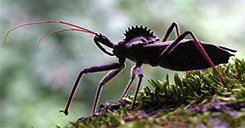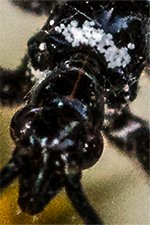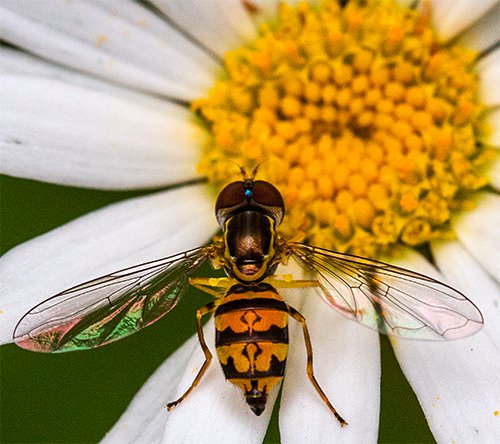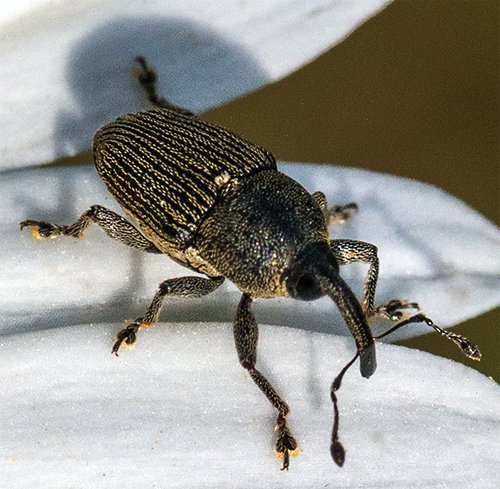|
HOME: www.hiltonpond.org |
|||
THIS WEEK at HILTON POND Subscribe for free to our award-winning nature newsletter (Back to Preceding Week; on to Next Week) |
All text, maps, charts & photos © Hilton Pond Center WHOOPS-A-DAISY, Ox-eye Daisies (above and below) are nearly ubiquitous in open areas across much of temperate North America, with Hilton Pond Center being no exception. At this time of year these members of the Sunflower Family (Asteraceae) erupt to grace local roadsides and our small meadows with thousands of white and yellow flower heads. Three hundred years ago, however, spring would not have seen daisies in the Carolina Piedmont because they're not native; early settlers accidentally introduced the plant (whoops-a-daisy!) from its natural range in Europe and Asia. Once known by the poetic name of Chrysanthemum leucanthemum, this foreign invader now goes by the scientific epithet Leucanthemum vulgare--the species label indicating the plant's "vulgarity," or commonness.
All text, maps, charts & photos © Hilton Pond Center In reality--and despite its aesthetic qualities and usefulness as an indicator of affection ("she loves me, she loves me not")--Ox-eye Daisy can become a noxious weed whose dense colonies crowd out native species (again, whoops-a-daisy!). Despite this major shortcoming, the common daisy appears to play a positive environmental role, providing nectar and pollen and even mating and hunting grounds to a wide variety of tiny native creatures (ups-a-daisy!). As evidence, this week at Hilton Pond we went out with our 100mm macro lens to sample a diversity of insects and other invertebrates that may actually depend on daisies when native flora is scarce or absent. We've written about the daisy microhabitat before, but it's always fun to see what new critters are hanging out atop these white and yellow asters. Keep in mind as you examine the macrophotographs this sense of scale: The "eye" of Ox-eye Daisy--comprised of scores of minute disk flowers--is only an inch across and those white ray flowers around the perimeter (they're NOT petals!) are a merely quarter-inch wide and an inch long.
All text, maps, charts & photos © Hilton Pond Center The first insects we noticed on our Ox-eye Daisies were numerous tiny black beetles (above) with tucked-under heads and pointed abdomens that stuck out past rear edges of their hard wing covers. These, without a doubt, were members of the Tumbling Flower Beetle Family (Mordellidae), a name that stems from the insect's seemingly uncoordinated habit of pushing off with one foot as it moves around on the flower head. Sometimes called Pintail Beetles because of their abdominal shape, mordellids can be predaceous on other small arthropods; most are leaf or stem miners whose larvae live in plant pith or rotten wood. We suspect the adult in the photo above was taking a sweet snack of daisy nectar.
All text, maps, charts & photos © Hilton Pond Center On several daisies we found a second kind of very dark insect (above)--one that at first glance appeared to be another beetle. When we counted five segments on each antennae, however, we realized we had a member of the True Bug Order (Hemiptera) in the Corimelaenidae--the beetle-like Ebony Bug Family. (NOTE: Older field guides refer to these as "Negro Bugs," a name we're glad is no longer in common use.) Ebony Bugs and their close relatives are generically called "shield bugs" because of a large scutellum that covers the abdomen. Adult and nymphal Ebony Bugs feed mostly on seeds and grains, and sometimes on roots.
All text, maps, charts & photos © Hilton Pond Center The second hemipteran we found atop a daisy (above) was instantly recognizable as the red-bellied nymph of the Wheel Bug, Arilus cristatus, a predatory insect that pierces other insects with its sharp, hooked stylus (adult, below right) and sucks out bodily fluids.
All text, maps, charts & photos © Hilton Pond Center And speaking of Tachinid Flies, we actually did find one (above) on a daisy. It appeared not to be eating nectar or pollen, so it's likely it was simply waiting for a host upon which to lay an egg--or two or three. Most tachinids are "protelean parasitoids" that start out as internally parasitic larvae that emerge as adults after killing the host. ("True parasites" live on their hosts without killing them.) Many tachinids are endoparasitic on larval sawflies, moths, or butterflies, while others lay eggs on adult beetles, true bugs, or grasshoppers. (We don't have a specific I.D. for the red-eyed tachinid above; it's probably Phasia sp. If you know a common and/or scientific name for it or any other unidentified insects on this page, please send us an e-mail at INFO.)
All text, maps, charts & photos © Hilton Pond Center A different-looking fly with red on the OTHER end of its body is shown above. This specimen waved its brightly colored abdomen up and down as it used its long proboscis to take nectar from one daisy disc flower after another. At first we thought this was an Empidid Fly but correspondents have suggested it was another tachinid, likely Cylindromyia sp. We wondered if the fly's abdomen-waving habit might be a way to attract curious insects that end up as repositories for the fly's eggs. Incidentally, note the two wings that make this insect a True Fly (Diptera), and the short, stiff antennae--also a characteristic of flies.
All text, maps, charts & photos © Hilton Pond Center Yet another large-ish True Bug was perched on a daisy flower head that had already begun to set seed; it was a 1.5-inch-long Leaf-footed Plant Bug, Leptoglossus phyllopus (above), so-called because of the flattened, leaf-like tibia on each hind leg. This species is an agricultural pest on such crops as peaches and tomatoes that are damaged and made unmarketable when the insect punctures the skin and sucks out nutritional juices.
All text, maps, charts & photos © Hilton Pond Center We found several Leaf-footed Bugs on past-prime daisies, suggesting they might be using the flower heads as mating platforms rather than nectar or pollen sources. Indeed, on one wilted inflorescence (above) there were THREE individuals slowly chasing around, stroking one another with their antennae in what likely was a bug-speed courtship ritual. We were surprised to see fully grown Leaf-footed Bugs so early in the season and wondered whether some or all overwinter as adults.
All text, maps, charts & photos © Hilton Pond Center We're pretty sure the insect above is the nymph of a Bush Katydid (Tettigoniidae), possibly a Scudderia sp.; immature insects are often difficult to identify, so it might be something else. Based on hind leg structure this organism is certainly an orthopteran--a member of the order that includes jumping insects: Grasshoppers, crickets, locusts, and their kin. Of particular interest were the immature insect's long black-and-white-banded antennae, whose striking color pattern may draw a predator's attention away from the body of the nymph. Assuming it's a young Bush Kathydid, it will turn uniformly pale green as an adult.
All text, maps, charts & photos © Hilton Pond Center In our daisy patch we noticed several kinds of insects with four membranous wings, more-or-less narrow waists, and jointed short antennae. These were all members of the Hymenoptera--the order that includes bees, wasps, sawflies, and ants. Several, like the one above, were probably solitary native bees in the Halictidae, a "metallic bee" family in which some species are social, with a queen serviced by workers. The female halictid collects prodigious amounts of pollen--note all the yellow grains stuck to legs and abdomen of the one above--which she then takes back to a cell constructed within a hole in the ground. Adding nectar to sweeten and supplement the mass with carbohydrates, she lays her egg, seals off the cell, and goes on to create another provisioning chamber for future offspring. We should mention that as we were taking our photos in the field we noticed among the yellow disk flowers a long yellow structure (above) ; we then ignored it, thinking it was just some daisy floristic aberration.
All text, maps, charts & photos © Hilton Pond Center Upon downloading and processing the image, however, we made an interesting discovery: The elongated ocher-colored structure (above) was actually a larval insect--a perfectly camouflaged yellow caterpillar that reared high above the bee, striking what might be viewed as a menacing and defensive "don't mess with me" pose. Without having a specific identification we're guessing this is one of the so-called "inchworms," the larva of a Geometer Moth (Geometridae). An inchworm has the usual six insect legs and well developed claspers as the end of the abdomen but lacks a full set of five proleg pairs found in most moth and butterfly caterpillars. As a result, a geometrid cat holds on with its claspers, extends its body, releases its clasper, and draws its abdomen tip toward its anterior--resulting in that distinctive "inchworming" method of locomotion. Most inchworms eat leaves, flower parts, pollen, or nectar, hence the presence of this yellow caterpillar on a daisy.
All text, maps, charts & photos © Hilton Pond Center Undoubtedly the most colorful "whoops-a-daisy, up-a-daisy" arthropod we saw during our outing was the one in the photo just above. A casual observer might suppose it was some sort of stinging insect--a bee or wasp--but these all have four membranous wings while this brightly patterned flyer had just two. Aha! It must be another dipteran, this time one of the Flower Flies in the Syrphidae, also referred to as Hover Flies. (Note also the presence of another fly characteristic: Tiny knob-like yellow "halteres" behind each extended wing. These are vestigial wings that now serve as gyroscopes that help a moving fly stay balanced.) Syrphids exhibit highly diverse lifestyles, with adults in most species subsisting on pollen and nectar; larvae, however, may prey on smaller insects or eat detritus. Among their favored foods are aphids and other plant-sucking insects that cause major crop damage, so Flower Fly larvae are welcomed by many farmers--especially when some of these immature insects also grow up to become important pollinators. Since our Flower Fly above, probably Toxomerus geminatus, does mimic a wasp or bee, you'd be correct in saying this is another example of aposematism.
All text, maps, charts & photos © Hilton Pond Center Through the years, one arthropod we've always managed to find on daisy flowers is the one shown above--a slightly fuzzy little insect bearing a long snout (rostrum) with paired antennae near its tip. This could be nothing other than a weevil (Curculionidae), a large group of strictly herbivorous beetles (Coleoptera); some of them--think "Boll Weevil"--have major impact on economic crops. This weevil's rostrum is tipped with grinding mouth-parts that rasp right through a seed, but even its larvae can wreak havoc on grains and fruits. Some weevils have host plant specificity, which could explain why we so often find this particular unnamed species on Ox-eye Daisy--undoubtedly dining on the compoisite flower's abundant pollen and nectar.
All text, maps, charts & photos © Hilton Pond Center The photo just above is a third example of our seeing something AFTER we got back to process our photos on the computer-- rather than while we were in the field with macro lens and camera. In this case we had been concentrating on one of those eighth-inch-long weevils and completely missed an even smaller fly to its right. We don't have an I.D. for this diminutive insect--perhaps one of the Fruit Flies (Drosophilidae)--but it undoubtedly is the smallest arthropod we've ever photographed on a daisy.
All text, maps, charts & photos © Hilton Pond Center We've already mentioned several predatory insects that hang out on Ox-eye Daisy--the red-bellied Wheel Bug nymph in particular--but perhaps the baddest arthropod on the block was a tan and black Northern Crab Spider, Misumenops asperatus (AKA Mecaphesa asperata, above). This arachnid lies in wait on a daisy edge before lunging out to grab its next meal with those long front pairs of legs. A quick swipe of the spider's fangs and the prey is paralyzed--no web needed to snare its hapless food item. Crab spiders aren't all that particular, taking anything they can catch: Flies, bees, wasps, bugs, and even butterflies. Note the two large anterior pedipalps ("mouth feet") that help manipulate prey items, and the eight eyes (four black and four white)--all the better to see you with, my dear.
All text, maps, charts & photos © Hilton Pond Center Whoops-a-daisy, ups-a-daisy . . . each of these flower-dwelling organisms we photographed at Hilton Pond Center is interesting in its own right--especially when we consider how all are uniquely adapted to their various ecological roles. We hope we've piqued your interest and that you'll wander into your own neighborhood daisy patch to see what tiny creatures might be out and about. Take your macro lens or a hand magnifier, or just turn around your binoculars when birding gets slow. Even though Ox-eye Daisies in your area may be past their flowering prime by now, there are always other blossoms to examine--particularly non-native Queen Anne's Lace or native asters like Daisy Fleabane. Their invertebrate inhabitants are certain to be just as diverse and fascinating as those on Leucanthemum vulgare. All text, maps, charts & photos © Hilton Pond Center POSTSCRIPT: Thanks to Mike Howell of Samford University and Harsi Parker of Vashon WA for suggesting identifications of some arthropods in the photo essay above.
All contributions are tax-deductible on your |
|---|
|
"This Week at Hilton Pond" is written and photographed by Dr. Bill Hilton Jr., executive director of Hilton Pond Center for Piedmont Natural History.
|
|
|
Please refer "This Week at Hilton Pond" to others by clicking on this button: |
Comments or questions about this week's installment? Send an E-mail to INFO. (Be sure to scroll down for a tally of birds banded/recaptured during the period, plus other nature notes.) |







 Like many bugs, when disturbed this one emits a foul-smelling, bad-tasting aldehyde, so we suspect the scarlet hue of the immature's abdomen is an example of "aposematism"--the use of bright colors or patterns that warn predators to back away lest they get a mouthful of nastiness. At two-inches in length, the adult Wheel Bug is the largest terrestrial hemipteran in the Carolinas,
Like many bugs, when disturbed this one emits a foul-smelling, bad-tasting aldehyde, so we suspect the scarlet hue of the immature's abdomen is an example of "aposematism"--the use of bright colors or patterns that warn predators to back away lest they get a mouthful of nastiness. At two-inches in length, the adult Wheel Bug is the largest terrestrial hemipteran in the Carolinas,  while the nymph in our photo was less than an inch from "nose to tail tip." Even though potential predators might be deterred by the nymph's abdominal color, our photo reveals this immature Wheel Bug apparently had other problems with which to deal: Nearly invisible white objects riding atop its thorax between the first and second pair of legs might be a herd of mites, or maybe eggs of some parasite such as a Tachinid Fly.
while the nymph in our photo was less than an inch from "nose to tail tip." Even though potential predators might be deterred by the nymph's abdominal color, our photo reveals this immature Wheel Bug apparently had other problems with which to deal: Nearly invisible white objects riding atop its thorax between the first and second pair of legs might be a herd of mites, or maybe eggs of some parasite such as a Tachinid Fly. 




















 Please report your
Please report your